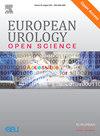Omission of Contralateral Systematic Biopsies in Unilateral Suspicious Prostate Cancer on Magnetic Resonance Imaging: Implications for Radiation Treatment Selection
IF 3.2
3区 医学
Q1 UROLOGY & NEPHROLOGY
引用次数: 0
Abstract
Background and objective
A combined approach of magnetic resonance imaging (MRI) targeted biopsies (TBx) and systematic biopsies (SBx) was recommended previously in patients with unilateral suspicious prostate cancer (PCa) on MRI. Yet, new PCa guidelines suggest that contralateral SBx can be omitted. It is unknown how this guideline modification impacts treatment selection. This study evaluates the value of contralateral SBx in radiation treatment selection in patients with unilateral suspicious lesions (Prostate Imaging Reporting and Data System [PI-RADS] ≥3) on MRI.
Methods
Case files of 80 patients with a unilateral suspicious lesion on diagnostic MRI who underwent TBx and bilateral SBx were collected. The cases were presented to four radiation oncologists twice: once with diagnostic information of bilateral SBx and TBx, and once with diagnostic information of ipsilateral SBx and TBx pathology results. Based on this information, external beam radiation treatment (EBRT) fractionation scheme, duration of androgen deprivation therapy (ADT), and feasibility of brachytherapy (monotherapy or brachyboost) were considered.
Key findings and limitations
After omitting information of contralateral SBx pathology results, selection of EBRT fractionation scheme and ADT duration changed in 14% (95% confidence interval [CI] 9.8–17) and 15% (95% CI 11–19) of cases, respectively. The feasibility of brachytherapy as monotherapy and brachyboost, respectively, changed in 11% (95% CI 7.9–15) and in 21% (95% CI 17–26) of cases, with overall poor interobserver variability for both diagnostic scenarios (Fleiss’ kappa 0.15 and 0.16).
Conclusions and clinical implications
Our findings indicate that omitting contralateral SBx has an impact on the treatment selection of patients who choose for radiation therapy as their treatment for locally confined PCa.
Patient summary
In patients with prostate cancer identified via magnetic resonance imaging on one side of the prostate, exclusion of prostate biopsies from the opposite side affected the selection of radiation treatment.
单侧可疑前列腺癌在磁共振成像上遗漏对侧系统活检:对放射治疗选择的影响
背景与目的磁共振成像(MRI)靶向活检(TBx)和系统活检(SBx)联合治疗单侧MRI可疑前列腺癌(PCa)患者。然而,新的前列腺癌指南建议可以忽略对侧SBx。目前尚不清楚该指南的修改如何影响治疗选择。本研究评价对侧SBx在单侧可疑病变(前列腺影像学报告与数据系统[PI-RADS]≥3)MRI患者放射治疗选择中的价值。方法收集80例单侧可疑病变诊断MRI行TBx和双侧SBx的病例资料。病例两次向4位放射肿瘤学家报告,一次提供双侧SBx和TBx的诊断信息,一次提供同侧SBx和TBx的病理结果诊断信息。基于这些信息,我们考虑了外束放射治疗(EBRT)分次方案、雄激素剥夺治疗(ADT)持续时间以及近距离治疗(单次治疗或近距离增强)的可行性。在忽略对侧SBx病理结果信息后,选择EBRT分离方案和ADT持续时间分别改变了14%(95%置信区间[CI] 9.8-17)和15% (95% CI 11-19)的病例。分别在11% (95% CI 7.9-15)和21% (95% CI 17-26)的病例中,近距离治疗作为单药治疗和近距离增强治疗的可行性发生了变化,两种诊断方案的观察者间可变性总体较差(Fleiss ' kappa 0.15和0.16)。结论和临床意义我们的研究结果表明,忽略对侧SBx会影响局部局限性前列腺癌患者选择放射治疗的治疗选择。对于单侧前列腺磁共振成像确诊的前列腺癌患者,排除对侧前列腺活检影响放射治疗的选择。
本文章由计算机程序翻译,如有差异,请以英文原文为准。
求助全文
约1分钟内获得全文
求助全文
来源期刊

European Urology Open Science
UROLOGY & NEPHROLOGY-
CiteScore
3.40
自引率
4.00%
发文量
1183
审稿时长
49 days
 求助内容:
求助内容: 应助结果提醒方式:
应助结果提醒方式:


